DSAG Investment Report 2019: More education on digitization needed
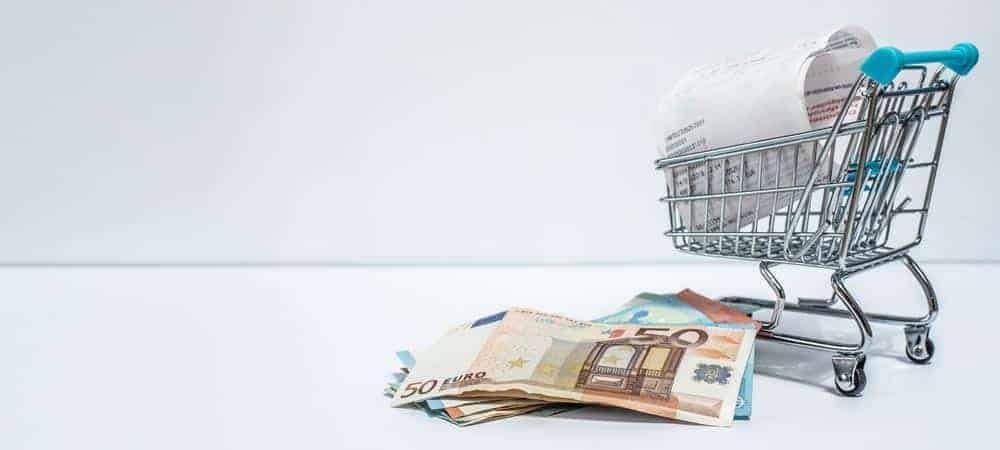

As is the case every year, the DSAG Investment Report was published at the end of January. It always paints a crystal-clear picture of the SAP community that is all too often diametrically opposed to the statements made by SAP CEO Bill McDermott and his CFO Luka Mucic at SAP's financial press conference.
SAP believes that it has done everything right and is well on its way to 2025. The DSAG investment report shows clear gaps in SAP's strategy and paints a sobering picture with regard to the operational adaptation of Hana, S/4 and Leonardo.
If the investment report is even partially correct, many existing SAP customers will not be able to make the S/4 release switch by 2025. What then?
From the point of view of the DSAG Investment Report, there are numerous topics that occupy SAP's existing customers. On the SAP side, it is manageable: C/4, Hana and Cloud.
But SAP also knows that things are getting out of hand in the area of "cloud computing" - the counter-strategy: Embrace! At this year's SAP's Field Kick-off Meeting (Fkom), SAP tried to embrace and cling to the partners and above all the hyperscalers in order to salvage anything left of SAP's cloud strategy!
Because SAP still hasn't managed to provide a "breathing" cloud to its existing customers. With AWS, GCP and Azure, it can always go both ways. The user pays for consumption. With SAP, however, the existing customer books services and licenses without the option of returning them.
With "Embrace", the ERP world market leader now wants to follow the success of the hyperscalers. However, based on the DSAG investment report, it is very doubtful whether this will succeed. After all, Google and Amazon themselves are struggling with major acceptance problems in the SAP community. It is not unlikely that "Embrace" will be a battle of Waterloo for SAP, Google and Amazon.

In parallel to SAP's Fkom, the DSAG Investment Report provides a more differentiated picture: Big Data, Internet of Things, and artificial intelligence or machine learning are the top three digitization topics among members of the German-speaking SAP User Group (DSAG). SAP users have planned or already started projects in these areas. This is the result of the DSAG Investment Report 2019.
However, respondents are more skeptical about digitization efforts in their companies than they were a year ago. The SAP Leonardo engine is sputtering: SAP is finding it very difficult to position the Leonardo framework in the SAP community.
Even at the SAP Capital Markets Day 2019 on February 7 at the New York Stock Exchange, "Leonardo" could not be correctly classified: The graphic shown there moved the "hour of birth" of SAP Leonardo to 2018 - however, SAP Leonardo has been around since 2016 and SAP already held a successful Leonardo conference in Frankfurt/M. in 2017.
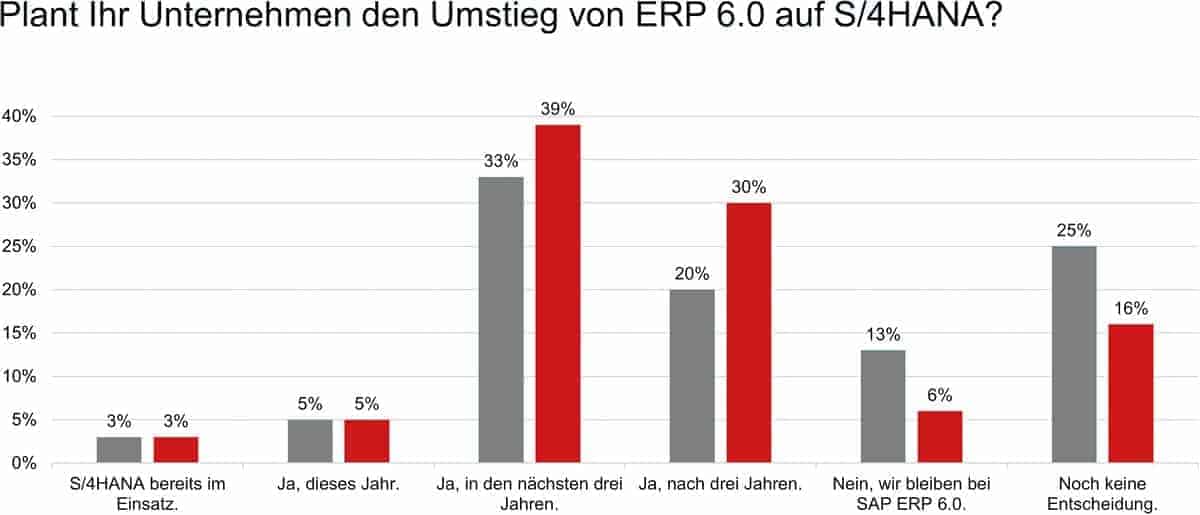
Expiration date 2025
SAP's 2025 deadline: SAP is still officially sticking to the ERP/ECC 6.0 expiration date. However, the DSAG investment report shows a picture according to which this plan can hardly still succeed. Converting the Business Suite (ERP/ECC 6.0) to Hana and S/4 is planned at a large number of the companies surveyed.
Only implementation is currently not proceeding as quickly as expected and completed projects are not yet available in large numbers. With regard to the relevance of SAP products, one result is that the Business Suite is already mature in many companies.
Main investments in the ERP solution are therefore decreasing for the third year in a row and also significantly (2017: 33 percent, 2018: 29 percent, 2019: 10 percent). However, investments in S/4 are not increasing to the same extent. They remain at 14 percent.
In connection with investments for digitization efforts, DSAG member companies continue to differentiate between existing and new business models. The focus on existing business processes has increased again (plus five percentage points), reaching 90 percent.
"Many companies are looking at ERP and that means they are looking at existing business processes. This explains the high number of planned S/4 Hana projects, as S/4 is often equated with digitization."
explains Marco Lenck, Chairman of the Board of DSAG.
More than two-thirds of respondents consider investments in new business models to be important. This increases their relevance by two percentage points.
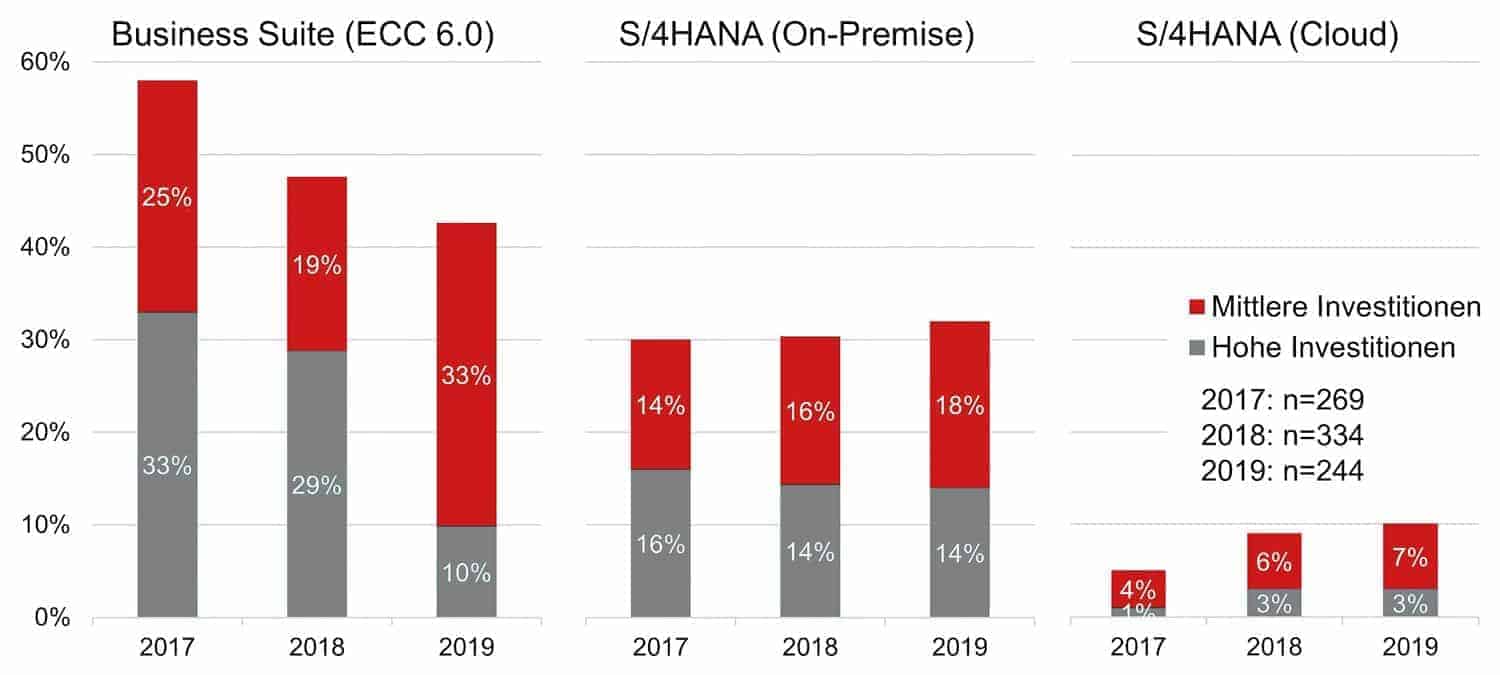
DSAG member companies continue to invest in IT in general. For 40 percent of respondents, the budget is increasing by around 16 percent compared to the previous year.
For around half, the budgets remain the same. Investments are not differentiated by sector. Trade, services and manufacturing behave similarly.
Investments in ERP and Cloud
Some of the freed-up budgets are moving into cloud solutions. 16 percent of companies are planning medium and high investments in SuccessFactors. This figure is on a par with the previous year.
SAP Analytics Cloud grew significantly to nine percent, up six percentage points. The SAP Cloud Platform doubled its mid-market investment to eight percent. The Integrated Business Planning solution has also reached eight percent.
SAP's new CRM C/4, which includes solutions such as Hybris, is worth medium and high investments for twelve percent of companies. At this point in time, however, C/4 equals Hybris and this Swiss e-commerce product is of known good quality.
The direction in which C/4 will develop with the Callidus Cloud and Qualtrics (see SAP graphic) was naturally not yet known at the time of the DSAG survey for the 2019 Investment Report.
In addition, DSAG members invest in projects in the aforementioned focus areas of Big Data, Internet of Things, Artificial Intelligence/Machine Learning and Robotic Process Automation.
End of the flagpole
After the aforementioned SAP Capital Markets Day, a financial analyst from the Dow Jones news network commented on the words of SAP CFO Luka Mucic at the Goldman Sachs technology conference - also in New York - saying, "SAP's CFO reiterated management's commitment to margin growth this year.
"Investors won't have to wait long to see the progress"
Mucic promised at the Goldman Sachs technology conference.
For the next two years, he also definitely ruled out major acquisitions that would have to be financed through debt. The portfolio is now well composed, he said, and the focus is on taking advantage of the recent acquisitions for further growth.
In 2018, SAP had invested around ten billion dollars for the two major acquisitions Callidus and Qualtrics and financed this with Eurobonds of 4.5 billion euros, among other things.
According to Luka Mucic, the margin will be boosted by a number of factors: In the cloud business, the gross margin is expected to increase by eight percentage points, which will also give a strong boost to the overall ratio.
In addition to the expected strong growth in the cloud and the associated economies of scale, the increasing number of contract renewals also meant that costs were lower than for new contracts. The completion of the platform migration, which is targeted for this quarter, will also help.
In addition, sales and marketing costs would go down overall. Mucic again called for confidence in the new business model. Work on the C/4 cloud platform would now be prioritized after the adjustments to the Hana database platform had been finalized.
What distinguishes SAP from others is the linking of both structures. This enables the company to offer complete solutions, from customer relationship management to the supply chain and corporate management with enterprise resource planning. (End of Dow Jones quote)
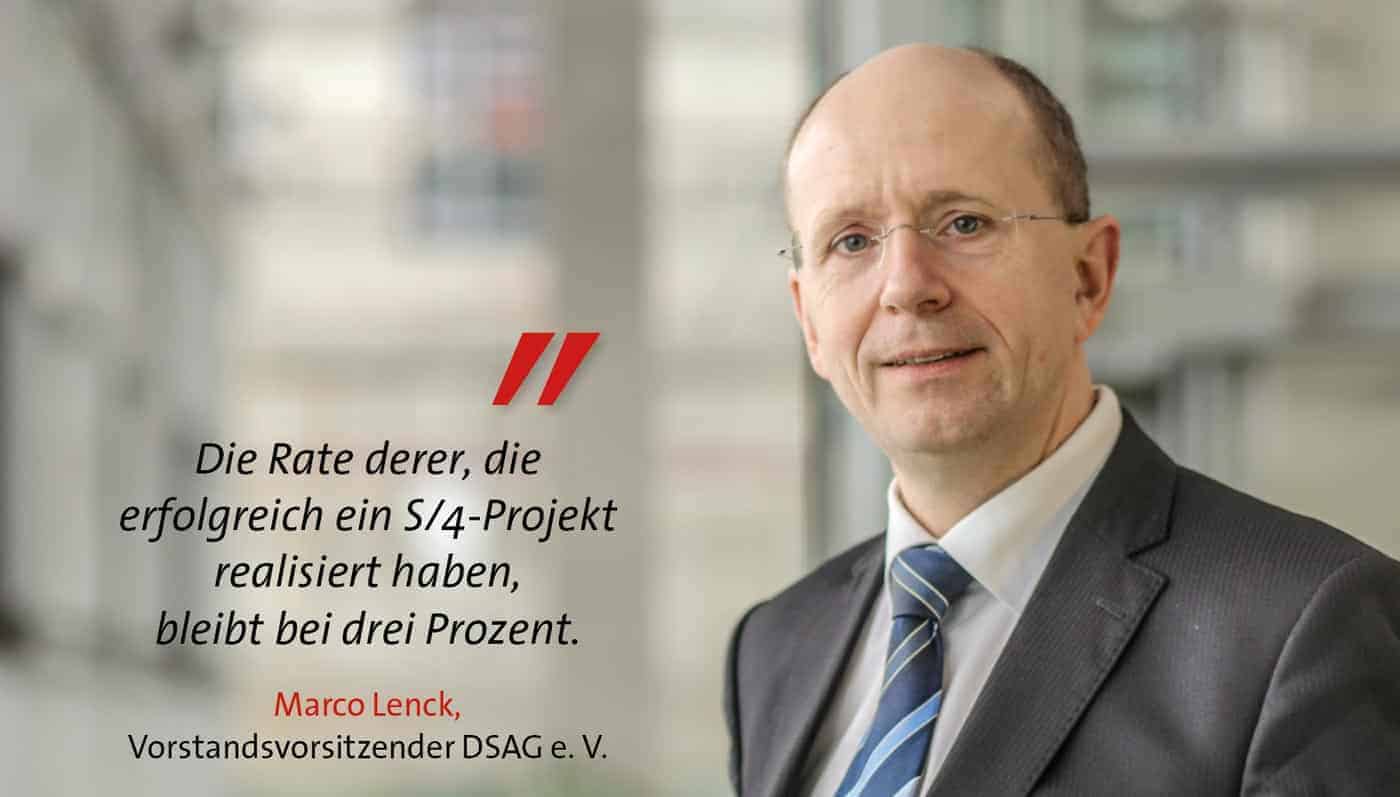
CFO Luka Mucic's speech at the SAP Capital Markets Day and at Goldman Sachs can be summarized as follows: SAP has done all its homework perfectly.
The business model now consists of revenue targets and more profit! However, the reality is different, as the DSAG investment report and also a look at Hana as an example show:
There have been three emergency patches in the past four months, and even in SAP's internal IT, the transition from Hana 1 to Hana 2 is far from complete. As of October 1 last year, 41 percent of all Hana systems at SAP were still on version 1.
As every year, members were surveyed about the conversion of the Business Suite to S/4 Hana. It can be seen from the figures that companies have far-reaching plans in this regard.
Five percent still want to switch this year, 39 percent in the next three years (plus six percentage points), and another 30 percent after this period (plus ten percentage points).
"All but a quarter of companies have made a clear decision to make the switch"
Marco Lenck interprets the results.
"Still, the rate of those who have implemented projects is faltering. This remains at three percent."
This could be due to the fact that companies are currently initiating projects that take longer or are focusing on brownfield implementations where the complete move from one system to another is complex. Often, however, the effort involved was initially misjudged.
In connection with investments for digitization efforts, DSAG member companies continue to differentiate between existing and new business models. The focus on existing business processes has increased again (plus five percentage points) and reaches 90 percent.
"Many companies deal with ERP and that means they look at existing business processes. This explains the high number of planned S/4 Hana projects, as S/4 Hana is often equated with digitization."
Marco Lenck explains.
More than two-thirds of respondents consider investments in new business models to be important. This increases their relevance by two percentage points.
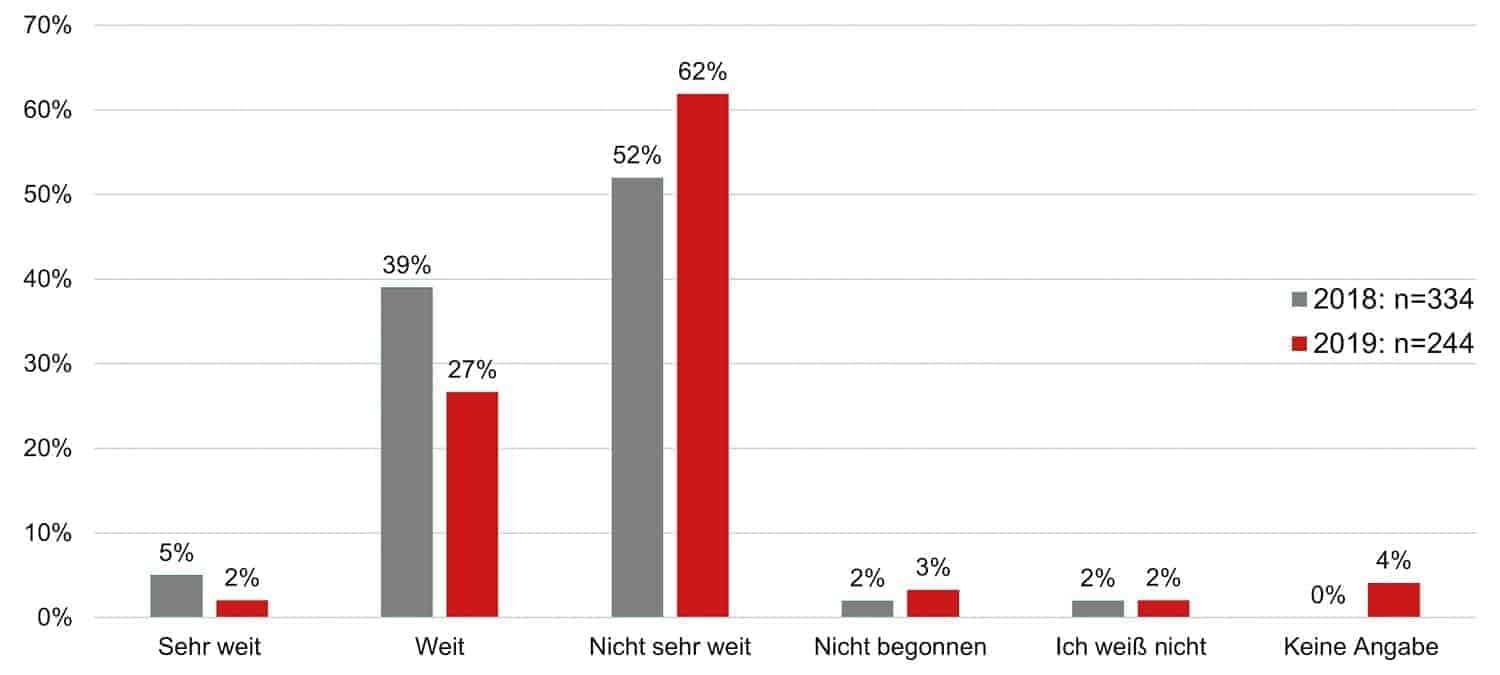
Conclusion: Educate together
The following demands and tasks can be derived from the results of the DSAG Investment Report. There is a continuing need for educational work on digitization in companies. There is a lack of illustrative examples and best practices here. DSAG is placing a focus on this.
Marco Lenck on this:
"Together with SAP, we want to work on supporting DSAG members with valuable information and assessments on the licensing model, S/4 Hana, C/4 Hana and other solutions that can be used to realize digitization projects."
But: Even if the importance of S/4 Hana continues to grow, the Business Suite is still here to stay:
"SAP customers who can't keep up with the pace of change must not be left behind, for example by a significant functional thinning of Business Suite"
demands Marco Lenck.
"There will still be a long transition period where both solutions will be used."
Thematically, DSAG will continue to focus more on Big Data, Internet of Things and Artificial Intelligence as well as Machine Learning in 2019 in order to make its members fit for digitalization.






